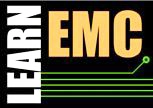EMC Question of the Week: August 8, 2022

To ensure compliance with EMC requirements, most low-speed digital I/O traces longer than a few centimeters that connect to a high-speed microcontroller should have
- series resistors
- controlled impedances
- matched terminations
- guard traces
Answer
The best answer is “a.” While controlled impedances and matched terminations may be required for signals with the highest bit rates, most of the I/O traces do not require a matched termination. In fact, it is usually undesirable to match the terminations of digital circuits that do not require it for signal integrity purposes.
The majority of digital I/O on a microcontroller is relatively low-speed (e.g. status, enable, reset). Placing a resistor in series with these I/O traces helps to attenuate high-frequency clock noise coming from the controller. It also helps to prevent fast transients (e.g. ESD) from triggering an undesired controller response.
Note that series resistors are not required for microstrip or stripline traces that travel a short distance and clearly do not couple significantly to other components or traces. When reviewing a board layout, it's generally a good idea to start with the assumption that every digital I/O trace needs a series resistor. These resistors can then be eliminated for traces that can't tolerate them or clearly don't need them.
BTW: Guard traces are only appropriate in a few very specific circumstances. They are rarely applied to digital traces in multi-layer PCB designs.
Have a comment or question regarding this solution? We'd like to hear from you. Email us at
